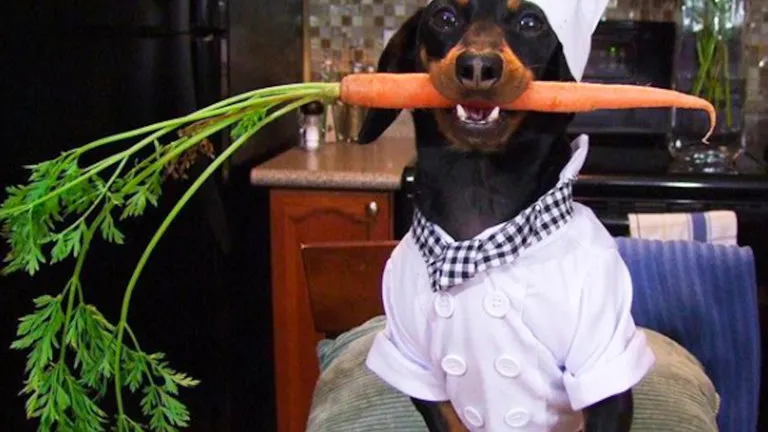Many dog owners find preparing homemade dog food highly rewarding. Watching your canine companion thrive and knowing exactly what they are consuming can be incredibly reassuring, especially when aiming for weight management. If you have the time and dedication, creating homemade dog food recipes vet approved for weight loss can be an excellent option for your pooch to shed those extra pounds. These recipes are designed to be easy, cost-effective, and nutritionally balanced, helping your dog reach and maintain a healthy weight. Forget about high-calorie treats; our focus is on wholesome meals that promote a lean physique.
Understanding Nutrition and Calories in Homemade Dog Food for Weight Loss
A crucial aspect of effective dog weight loss is precise calorie control. Each of the homemade dog food recipes detailed below includes its protein and calorie content. For dogs needing to lose weight, knowing their daily calorie requirements makes it simple to accurately count calories and ensure they receive appropriate portions. While the idea of homemade meals is appealing, it’s vital to recognize that many homemade dog food recipes lack proper nutritional balance. Over time, an imbalanced diet can lead to serious developmental disorders and other significant health issues. Therefore, carefully following vet-approved guidelines is paramount.
Essential Considerations for Preparing Homemade Dog Food
Crafting your own Homemade Dog Food For Weight Loss requires adherence to specific best practices to ensure safety, efficacy, and nutritional completeness.
- Proper Storage is Key: Homemade dog food is highly susceptible to rapid bacterial and fungal growth if not handled correctly. Always refrigerate or freeze your prepared homemade dog food in sealed containers at less than 4 degrees Celsius (32-39.2 degrees Fahrenheit).
- Shelf Life: Use refrigerated homemade dog food within 3 days. Before serving, always check for any unusual odors or color changes. Serve the food at a temperature just below body temperature, and if defrosting or warming in a microwave, ensure there are no hot spots that could burn your dog’s mouth.
- Supplementation is Non-Negotiable: Homemade dog food, particularly for weight loss, must be supplemented with calcium and specific dog vitamin and mineral powders. These supplements are not optional; they are essential to provide a complete and balanced diet.
- Accurate Portions: Each recipe provided here yields approximately 1000 kcal. The exact serving size for your dog will be determined by their individual dieting calorie requirement, which should be calculated with your veterinarian. This ensures your dog consumes the right amount of food to promote healthy weight loss.
- Precision in Measurement: Use kitchen scales to accurately measure all ingredients. This precision is critical for maintaining the specified protein and calorie content of each recipe, directly impacting the effectiveness of your dog’s weight loss journey.
- Supplement Timing: Never cook or heat the vitamin/mineral supplement. Instead, add it to the meal just before feeding to preserve its nutritional integrity.
 A dachshund named Crusoe looking attentive.Preparing balanced homemade dog food requires careful attention to detail and appropriate supplementation.
A dachshund named Crusoe looking attentive.Preparing balanced homemade dog food requires careful attention to detail and appropriate supplementation.
1. Chicken, Rice, and Vegetable Homemade Dog Food Recipe
This recipe is a wholesome option for a homemade dog food for weight loss plan, offering a good balance of lean protein, carbohydrates, and essential nutrients. When selecting ingredients, consider what type of meat is good for dogs to ensure you’re providing the best quality protein.
Nutrient Analysis: This recipe provides approximately 1000 kcal and 76 g protein. (Note: Ingredient weights refer to raw weights.)
Ingredients:
- Chicken breast (skinless): 290g (10oz)
- Brown rice: 145g (5oz)
- Broccoli: 46g (1.6 oz)
- Carrots: 46g (1.6 oz)
- Peas: 46g (1.6 oz)
- Extra Virgin Olive Oil: 2 ½ teaspoons
- Psyllium Powder: 2 tablespoons
Method:
- Cook brown rice according to packet guidelines until it is tender.
- Steam the broccoli, carrots, and peas until they are just tender but still retain some firmness.
- Cook the chicken breast. You can steam, microwave, or oven-bake it in a non-stick pan until thoroughly cooked.
- Once cooked, dice the chicken and vegetables into bite-sized pieces suitable for your dog.
- Combine the diced chicken and vegetables with the cooked rice in a large bowl.
- Stir in 2 ½ teaspoons of extra virgin olive oil.
- Add 2 level tablespoons of psyllium powder and mix thoroughly.
- Weigh the final product and portion it out precisely according to your dog’s specific dieting calorie intake.
- Just prior to serving, add a high-quality dog vitamin and mineral supplement. Alternatively, you can add ¼ teaspoon iodized salt, one crushed 25 mg zinc tablet, 1500 mg calcium, and one crushed multi-vitamin tablet (e.g., Centrum women). Mix these supplements thoroughly through the food before serving.
 A bowl of homemade dog food with various vegetables and meat.Always know the precise calorie count of all ingredients in your homemade dog food recipes to ensure effective weight management.
A bowl of homemade dog food with various vegetables and meat.Always know the precise calorie count of all ingredients in your homemade dog food recipes to ensure effective weight management.
2. Tuna and Vegetable Homemade Dog Food Recipe
For dogs who enjoy fish, this tuna and vegetable recipe offers another excellent option for homemade dog food for weight loss. Tuna is a lean protein source, making it ideal for calorie-controlled dog diets for weight loss recipes.
Nutrient Analysis: This recipe provides approximately 1000 kcal and 149g protein. (Note: Ingredient weights refer to raw weights.)
Ingredients:
- Canned tuna in water or brine, drained: 577 grams (20.4 oz)
- Potato, scrubbed or peeled: 288 grams (10.2 oz)
- Cauliflower: 138 grams (4.9 oz)
- Green beans: 138 grams (4.9 oz)
- Extra virgin olive oil: 2 ½ teaspoons
- Psyllium powder: 1 tablespoon
Method:
- Steam the potato, cauliflower, and green beans until they are tender.
- Dice the cooked vegetables into small pieces and mix them together.
- Break up the drained canned tuna and mix it evenly throughout the cooked vegetables.
- Add 2 ½ teaspoons of extra virgin olive oil and mix well.
- Stir in 1 level tablespoon of psyllium powder, ensuring it is evenly distributed.
- Weigh the cooked product and portion it according to your dog’s specific dieting calorie intake.
- Before serving, incorporate the necessary mineral and vitamin supplements. You can use a dog-specific vitamin and mineral supplement designed for home cooking. Alternatively, add ¼ teaspoon iodized salt, one crushed 25 mg zinc tablet, 1500 mg calcium, and one crushed multi-vitamin tablet (e.g., Centrum women). Mix these supplements thoroughly through the food prior to serving.
Important Considerations When Crafting Homemade Dog Food Recipes
Before embarking on the journey of creating your own homemade dog food recipes, especially for a specific goal like weight loss, it’s vital to ask yourself several critical questions to ensure success and your dog’s well-being. This foresight helps avoid common pitfalls and ensures your efforts are truly beneficial for your pet.
- Calorie Accuracy: Will you be able to precisely determine the calories in your dog food recipes? Utilizing human dieting applications like My Fitness Pal can assist in breaking down the calorie count of individual ingredients, offering a more scientific approach to portion control.
- Nutrient Ratios: Can you confidently ensure the correct nutrient ratios in your dog food recipes, particularly the critical calcium and phosphorus balance? Incorrect ratios can lead to serious health issues.
- Essential Nutrient Components: Are you capable of providing all essential nutrient components in your homemade dog food recipes? Achieving this without the aid of specially prepared supplements can be challenging, underscoring the importance of proper supplementation.
- Ingredient Availability and Cost: Have you factored in the cost and consistent availability of the ingredients required for your dog food recipes? Substituting ingredients due to supply shortages can alter the nutritional balance and calorie content, undermining your weight loss efforts.
- Dog-Safe Ingredients: Have you meticulously ensured that all ingredients are safe for dogs? Many human foods are toxic to canines; therefore, thorough research on homemade dog food for dogs with allergies or specific dietary needs is paramount to prevent adverse reactions.
- Selective Eating: Have you considered the possibility of selective eating, where your dog might pick out certain ingredients, like peas, from their meal? This behavior can alter your dog’s actual calorie intake and nutrient balance. Blending the finished product can often help prevent selective eating.
- Preparation Time: Have you realistically considered the preparation and cooking time involved in consistently making homemade dog food recipes? This can be a significant commitment.
- Storage Requirements: Have you considered the storage life of homemade dog food and the necessity for consistent refrigeration or freezing to maintain freshness and prevent spoilage?
The successful preparation of healthy, effective homemade dog food recipes, especially those tailored for weight loss, demands meticulous planning and unwavering attention to detail.
 Two puppies wearing chef hats, looking at a bowl of food.Homemade dog food recipes must be nutritionally balanced and properly stored; refrigerated meals should be consumed within 3 days.
Two puppies wearing chef hats, looking at a bowl of food.Homemade dog food recipes must be nutritionally balanced and properly stored; refrigerated meals should be consumed within 3 days.
When Homemade Isn’t an Option: Commercial Diet Dog Food
For some pet parents, the demands of preparing homemade dog food for weight loss are simply unfeasible due to time constraints or other challenges. Recognizing this, many commercial options are available that provide calorie-controlled, nutritionally balanced meals designed specifically for canine weight management. These diets often come with the backing of veterinary nutritionists, ensuring that your dog receives all necessary nutrients while still adhering to a strict calorie budget. Exploring commercial diet dog foods can be a practical alternative if homemade preparation isn’t sustainable for your lifestyle.
Introducing your dog to a safe workout routine and an individualized calorie plan can help them feel like a puppy again—shedding excess pounds and regaining their health, energy, and playful spirit. Consult with your veterinarian to determine the best approach for your dog’s weight loss journey, whether through homemade meals or a high-quality commercial diet.
